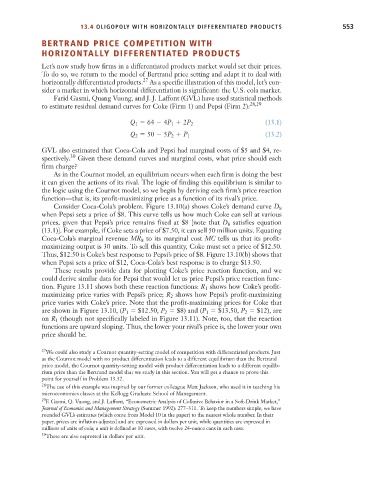Page 579 - Microeconomics, Fourth Edition
P. 579
c13marketstructureandcompetition.qxd 7/30/10 10:44 AM Page 553
13.4 OLIGOPOLY WITH HORIZONTALLY DIFFERENTIATED PRODUCTS 553
BERTRAND PRICE COMPETITION WITH
HORIZONTALLY DIFFERENTIATED PRODUCTS
Let’s now study how firms in a differentiated products market would set their prices.
To do so, we return to the model of Bertrand price setting and adapt it to deal with
horizontally differentiated products. 27 As a specific illustration of this model, let’s con-
sider a market in which horizontal differentiation is significant: the U.S. cola market.
Farid Gasmi, Quang Vuong, and J. J. Laffont (GVL) have used statistical methods
to estimate residual demand curves for Coke (Firm 1) and Pepsi (Firm 2): 28,29
Q 64 4P 2P 2 (13.1)
1
1
Q 50 5P P 1 (13.2)
2
2
GVL also estimated that Coca-Cola and Pepsi had marginal costs of $5 and $4, re-
spectively. 30 Given these demand curves and marginal costs, what price should each
firm charge?
As in the Cournot model, an equilibrium occurs when each firm is doing the best
it can given the actions of its rival. The logic of finding this equilibrium is similar to
the logic using the Cournot model, so we begin by deriving each firm’s price reaction
function—that is, its profit-maximizing price as a function of its rival’s price.
Consider Coca-Cola’s problem. Figure 13.10(a) shows Coke’s demand curve D 8
when Pepsi sets a price of $8. This curve tells us how much Coke can sell at various
prices, given that Pepsi’s price remains fixed at $8 [note that D satisfies equation
8
(13.1)]. For example, if Coke sets a price of $7.50, it can sell 50 million units. Equating
Coca-Cola’s marginal revenue MR to its marginal cost MC tells us that its profit-
8
maximizing output is 30 units. To sell this quantity, Coke must set a price of $12.50.
Thus, $12.50 is Coke’s best response to Pepsi’s price of $8. Figure 13.10(b) shows that
when Pepsi sets a price of $12, Coca-Cola’s best response is to charge $13.50.
These results provide data for plotting Coke’s price reaction function, and we
could derive similar data for Pepsi that would let us price Pepsi’s price reaction func-
tion. Figure 13.11 shows both these reaction functions: R shows how Coke’s profit-
1
maximizing price varies with Pepsi’s price; R shows how Pepsi’s profit-maximizing
2
price varies with Coke’s price. Note that the profit-maximizing prices for Coke that
are shown in Figure 13.10, (P $12.50, P $8) and (P $13.50, P $12), are
1
2
1
2
on R (though not specifically labeled in Figure 13.11). Note, too, that the reaction
1
functions are upward sloping. Thus, the lower your rival’s price is, the lower your own
price should be.
27 We could also study a Cournot quantity-setting model of competition with differentiated products. Just
as the Cournot model with no product differentiation leads to a different equilibrium than the Bertrand
price model, the Cournot quantity-setting model with product differentiation leads to a different equilib-
rium price than the Bertrand model that we study in this section. You will get a chance to prove this
point for yourself in Problem 13.32.
28 The use of this example was inspired by our former colleague Matt Jackson, who used it in teaching his
microeconomics classes at the Kellogg Graduate School of Management.
29 F. Gasmi, Q. Vuong, and J. Laffont, “Econometric Analysis of Collusive Behavior in a Soft-Drink Market,”
Journal of Economics and Management Strategy (Summer 1992): 277–311. To keep the numbers simple, we have
rounded GVL’s estimates (which come from Model 10 in the paper) to the nearest whole number. In their
paper, prices are inflation-adjusted and are expressed in dollars per unit, while quantities are expressed in
millions of units of cola; a unit is defined as 10 cases, with twelve 24-ounce cans in each case.
30 These are also expressed in dollars per unit.

